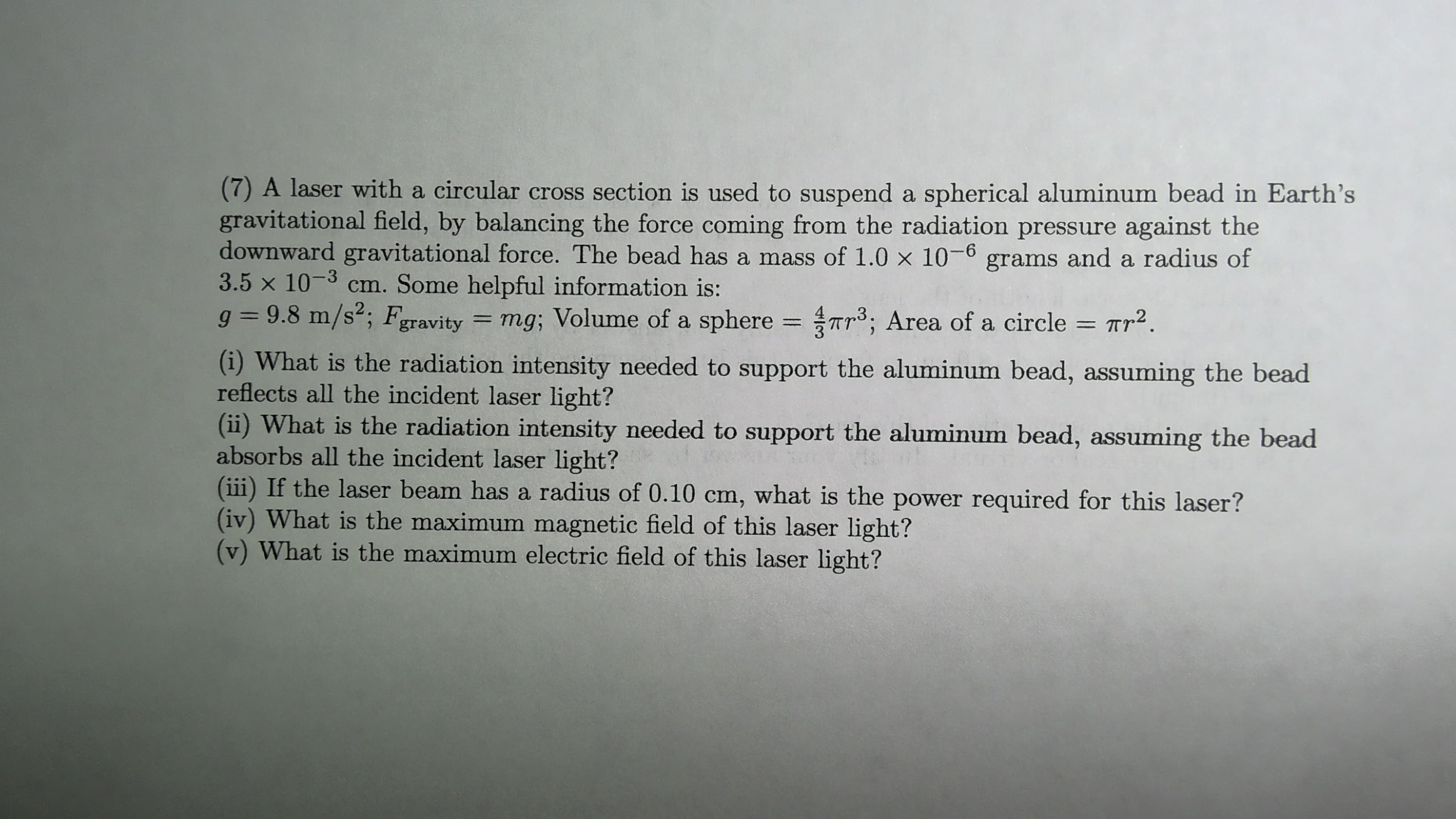(7) A laser with a circular cross section is used to suspend a spherical aluminum bead in Earth's gravitational field, by balancing the force coming from the radiation pressure against the downward gravitational force. The bead has a mass of 1.0 x 10-6 grams and a radius of 3.5 x 10-3 cm. Some helpful information is: g = 9.8 m/s2; Fgravity = mg; Volume of a sphere = r3; Area of a circle = Tr2. %3D %3D (i) What is the radiation intensity needed to support the aluminum bead, assuming the bead reflects all the incident laser light? (ii) What is the radiation intensity needed to support the aluminum bead, assuming the bead absorbs all the incident laser light? (iii) If the laser beam has a radius of 0.10 cm, what is the power required for this laser? (iv) What is the maximum magnetic field of this laser light? (v) What is the maximum electric field of this laser light?
(7) A laser with a circular cross section is used to suspend a spherical aluminum bead in Earth's gravitational field, by balancing the force coming from the radiation pressure against the downward gravitational force. The bead has a mass of 1.0 x 10-6 grams and a radius of 3.5 x 10-3 cm. Some helpful information is: g = 9.8 m/s2; Fgravity = mg; Volume of a sphere = r3; Area of a circle = Tr2. %3D %3D (i) What is the radiation intensity needed to support the aluminum bead, assuming the bead reflects all the incident laser light? (ii) What is the radiation intensity needed to support the aluminum bead, assuming the bead absorbs all the incident laser light? (iii) If the laser beam has a radius of 0.10 cm, what is the power required for this laser? (iv) What is the maximum magnetic field of this laser light? (v) What is the maximum electric field of this laser light?
Physics for Scientists and Engineers, Technology Update (No access codes included)
9th Edition
ISBN:9781305116399
Author:Raymond A. Serway, John W. Jewett
Publisher:Raymond A. Serway, John W. Jewett
Chapter34: Electromagnetic Waves
Section: Chapter Questions
Problem 34.25P
Related questions
Question

Transcribed Image Text:(7) A laser with a circular cross section is used to suspend a spherical aluminum bead in Earth's
gravitational field, by balancing the force coming from the radiation pressure against the
downward gravitational force. The bead has a mass of 1.0 x 10-6 grams and a radius of
3.5 x 10-3 cm. Some helpful information is:
g = 9.8 m/s2; Fgravity = mg; Volume of a sphere = r3; Area of a circle = Tr2.
%3D
%3D
(i) What is the radiation intensity needed to support the aluminum bead, assuming the bead
reflects all the incident laser light?
(ii) What is the radiation intensity needed to support the aluminum bead, assuming the bead
absorbs all the incident laser light?
(iii) If the laser beam has a radius of 0.10 cm, what is the power required for this laser?
(iv) What is the maximum magnetic field of this laser light?
(v) What is the maximum electric field of this laser light?
Expert Solution
This question has been solved!
Explore an expertly crafted, step-by-step solution for a thorough understanding of key concepts.
This is a popular solution!
Trending now
This is a popular solution!
Step by step
Solved in 3 steps

Knowledge Booster
Learn more about
Need a deep-dive on the concept behind this application? Look no further. Learn more about this topic, physics and related others by exploring similar questions and additional content below.Recommended textbooks for you

Physics for Scientists and Engineers, Technology …
Physics
ISBN:
9781305116399
Author:
Raymond A. Serway, John W. Jewett
Publisher:
Cengage Learning

Physics for Scientists and Engineers: Foundations…
Physics
ISBN:
9781133939146
Author:
Katz, Debora M.
Publisher:
Cengage Learning

University Physics Volume 3
Physics
ISBN:
9781938168185
Author:
William Moebs, Jeff Sanny
Publisher:
OpenStax

Physics for Scientists and Engineers, Technology …
Physics
ISBN:
9781305116399
Author:
Raymond A. Serway, John W. Jewett
Publisher:
Cengage Learning

Physics for Scientists and Engineers: Foundations…
Physics
ISBN:
9781133939146
Author:
Katz, Debora M.
Publisher:
Cengage Learning

University Physics Volume 3
Physics
ISBN:
9781938168185
Author:
William Moebs, Jeff Sanny
Publisher:
OpenStax


Principles of Physics: A Calculus-Based Text
Physics
ISBN:
9781133104261
Author:
Raymond A. Serway, John W. Jewett
Publisher:
Cengage Learning

Glencoe Physics: Principles and Problems, Student…
Physics
ISBN:
9780078807213
Author:
Paul W. Zitzewitz
Publisher:
Glencoe/McGraw-Hill